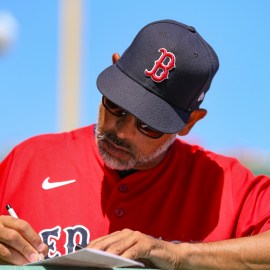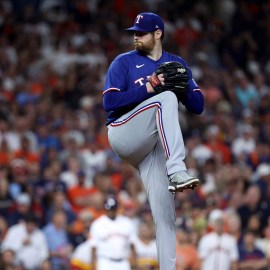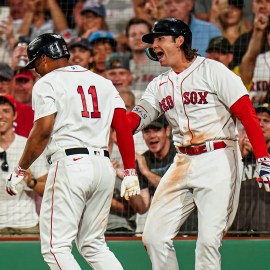The Boston Red Sox will prepare to embark on a clean slate as spring training action has officially commenced down in Fort Meyers, Florida.
Coming off a second consecutive last-place divisional finish, there are plenty of storylines to choose from when looking up and down Boston’s roster. Additions, departures and questions surrounding how Red Sox manager Alex Cora will structure the team’s lineup and rotation have already arisen and will be revisited in the coming weeks ahead of Opening Day on March 28.
Here are four to keep an eye out for:
1. Will the starting rotation bounce back with a few now-healthy arms back and ready to go?
It was clear that last season’s roster wasn’t equipped to compete with the rest of the American League East, and a large part of that was starting pitching.
Story continues below advertisement
Boston entered the year with Brayan Bello, Garrett Whitlock and James Paxton on the injured list, left to rely on Chris Sale, Corey Kluber, Tanner Houck, Nick Pivetta, and plenty of others to hold the fort down. The turnout wasn’t a favorable one, dragging the Red Sox from underdog hopefuls heading into the All-Star break to deep beneath the contention line.
Injuries haunted the rotation so much that Cora had no other choice but to lean on relievers to make short-inning opening starts. Going with that gameplan didn’t work either as Boston finished 19th among all MLB teams in ERA (4.52) and 23rd in shutouts thrown (23).
The front office responded to the urgent need for starting pitching help by signing Lucas Giolito to a one-year deal — Boston’s biggest offseason splash. Giolito went 8-15 with a 4.88 ERA with the Chicago White, Los Angeles Angels and Cleveland Guardians last season, pitching a career-high 184 1/3 innings.
There’s no question that re-stabilizing the rotation is critical for flipping the switch in 2024.
Story continues below advertisement
MORE RED SOX
2. How will Masataka Yoshida fare in the designated hitter’s role?
Masataka Yoshida jumped from professional baseball in Japan to MLB, attached with a handful of questions before the then-29-year-old stepped foot on a big league diamond for the first time.
Aside from some minor hiccups adjusting to the outfield, Yoshida showed promising signs after the Red Sox made a five-year, $90 million commitment, signing him as an international free agent. In the first half of Yoshida’s rookie campaign (78 games), he batted .316/.382/.492 and drew 27 walks with 36 strikeouts, hitting 10 home runs and 19 doubles.
Yoshida isn’t expected to abandon the outfield entirely, however, it does sound like Boston will experiment with his left-handed bat there in the lineup quite a lot in 2024.
“I’m not saying he’s the DH, but out of the group, he’ll get the most at-bats,” Cora told reporters at Fort Meyers on Tuesday.
Story continues below advertisement
In 2023, Yoshida made 205 plate appearances at DH and hit 255/.317/.388 with three home runs and 12 RBIs. That was a dip from Yoshida’s .309 batting average throughout 368 plate appearances as the starting left fielder, although with Justin Tuner — last season’s DH — now gone, the door is open.
3. What will the finalized outfield look like?
Similar to last season, the Red Sox have no shortage of options for establishing who will patrol what position in the outfield by Opening Day.
Including Yoshida, Boston has Jarren Duran, Tyler O’Neill, and Wilyer Abreu plus the option of plugging in Ceddanne Rafaela, who can play just about anywhere. That’ll leave plenty for Cora and the coaching staff to consider.
Duran showed an encouraging leap, batting .295 in 332 at-bats filling in for then-starting centerfielder Adam Duvall, and stretching singles into extra bases became a routine thing as the leadoff hitter. O’Neill is the newcomer, acquired from the St. Louis Cardinals in December, with a presumed starting role in the works while Abreu could make a run at the right field spot after making a short 28-game run coming up from Triple-A Worcester.
Story continues below advertisement
4. Is Vaughn Grissom the answer for improving the infield defense?
Vaughn Grissom joined the Red Sox as their return in the most jaw-dropping trade of the offseason in which Boston parted ways with Chris Sale, now of the Atlanta Braves.
Grissom, 23, got pushed out of Atlanta’s depth chart, opening the door for the ex-11th-round draft selection (2019) to be dealt. With an open spot at second base, Grissom becomes the prime candidate to split defensive duties in the middle infield alongside teammate Trevor Story.
“We’re young and exciting and then we have veterans just like every other team,” Grissom told reporters in January. “We have a couple of veterans out there that know the game’s ins and outs. We have (Rafael Devers) and Story and quite a few other guys. I’m really excited to get with this group.”
The Red Sox, last season, were the worst defensive team in the American League, making 102 errors only second to the MLB-worst San Francisco Giants (117).
Story continues below advertisement
In 44 big league appearances at second base with the Braves, Grissom notched a .974 fielding percentage, committing four errors in 153 defensive chances. Granted, that’s a small sample size, but Grissom is joining a youth-filled Red Sox team with plenty of roster members in a similar position.
Featured image via Eric Canha/USA TODAY Sports Images


















